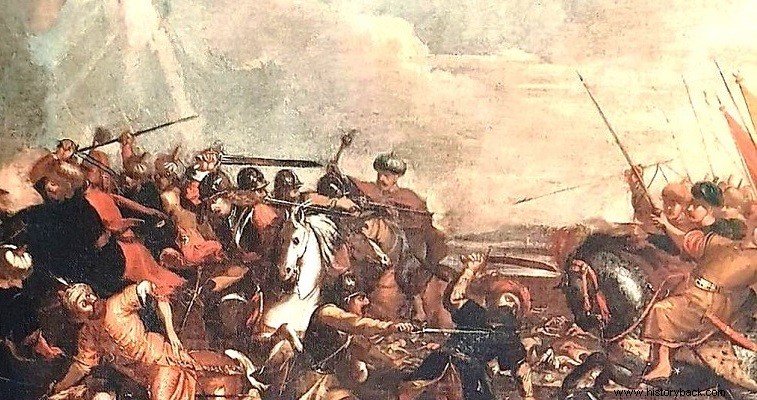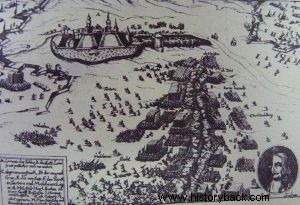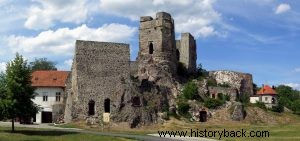
In the spring of 1664 another Turkish invasion of the lands of the Habsburg Empire was underway. A large Ottoman army had advanced as far as Hungary and Slovakia. The Turks spread over a large area facing the small Austro-German forces of Marshal Montecucoli.
Montecucoli deployed his approximately 25,000 men on the Raab River. Further south was the Croatian general of the Empire Zrinski, while in Slovakia was a small force of 8,500 men under the Huguenot general Louis de Soucet. The Turks moved towards the city of Leva and its castle (present-day Levice, Slovakia) which they besieged and then finally captured.
Sousse who wanted to lift the siege had moved there reinforced by 3,500 of Zrinski's men, led by the Croat himself. Thus 12,000 Imperial soldiers were gathered in the area. With this power at his disposal Sousse developed a prodigious activity. With lightning marches he surprised the Turks and after defeating a Turkish force in the battle of Zarnovitsa, he recaptured many areas that had been occupied by the Turks. Then he recognized Leva.
This development alarmed the Turks who wanted the city as a foothold to secure their new conquests. Thus a force of 20,000 Turks under Ali Pasha was sent to Leva with the intention of recapturing it. The Turks arrived in the area and Ali commissioned Shari Husayn to besiege the city, while he with the bulk of his forces covered the siege.
But the city was not now helpless. De Soucet moved against the Turks even though he had almost half their forces. The Christian force crossed the Chron River and on July 19, 1664, took up battle positions. At the sight of her the Turks lifted the siege, gathered their forces and prepared to fight. The field was defined by a series of villages (Starý Tekov, Hronské Kľačany and Podlužany).
Quality difference and strategy
Ali's force numbered, as stated, about 20,000 men. But the majority of them were miscreants, who took part in the war for the purpose of plunder and plunder. On the contrary, the smaller Christian force consisted of regular troops with high, even morale, due to their previous successes. Christian infantry regiments consisted of men armed with muskets and men armed with sarissas (in a ratio of 3:1, to 4:1 on average).
De Souce also proved to be a far better general than Ali the Turk. He hid a part of his army, so that it would be invisible to the enemies, in order to provoke the Turkish attack against him. The Turks, facing the few opponents, boldly decided to attack. Truly with yakhas for Allah the Turks attacked. They were joined by their Christian allies from present-day Romania and Moldavia. These men were a group without serious organic ties, without special training and without motivation.
So when they realized de Soucet's trap, they simply put it to their feet and ran away. Their flight also caused panic among the Turks who in turn fled, almost without fighting. Sousse of course took advantage of the flight of his opponents, pursued them and inflicted overwhelming losses on them. Ali's force lost about 8,000 men, compared to only 200 killed and wounded in Sousse's force.
This victory proved to be particularly important. The Christian forces took advantage of it by advancing to the Danube and destroying the Turkish floating bridges there at Sturovo in today's Slovakia (formerly Parkan) and laid the foundations for the great victory in the battle of St. Gotthard's Abbey on August 1, 1664.
Comte Jean-Louis Radouille de Soucet (1608-1682)
The winner of the battle, de Soucet, was a Frenchman. Under normal circumstances he should have been an enemy of the Habsburgs, and indeed for a time he was. He was the son of a Huguenot (Protestant) French nobleman and left his homeland at the age of 21 after fighting against the Roman Catholic King Louis XIII at the Battle of La Rochelle. He enlisted in the Swedish army and fought in the Thirty Years' War under Sweden's famous King Gustavus Adolphus.
In 1642, however, he clashed with the Swedish general Torsten Stalansk and left the Swedish service to join the Habsburg Imperial army. He fought well and particularly distinguished himself in the siege of Brno by repelling the Swedes... For his victory, he was promoted to the rank of general.
He fought again against the Swedes in 1657-1660 (Little Northern War). In 1663 he was sent to Hungary under the orders of the great marshal Montecucoli to deal with the Turks, whom he defeated at Leva. In 1674 he fought against the French in the Low Countries, but was defeated at Senefe by the great Comte. He died in 1682.


